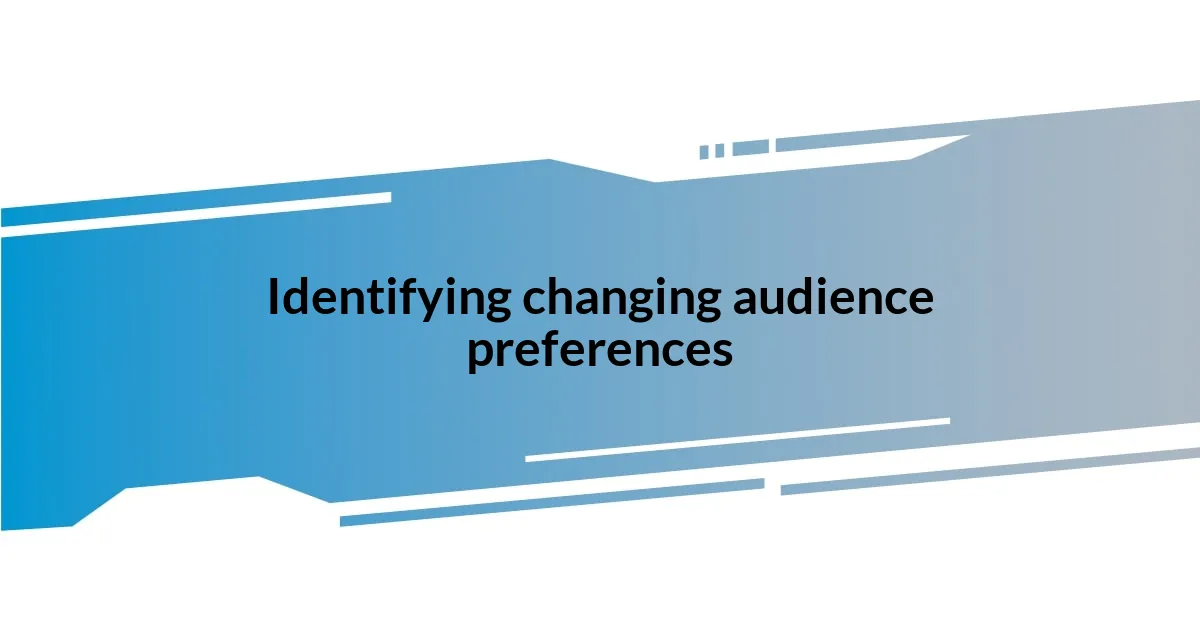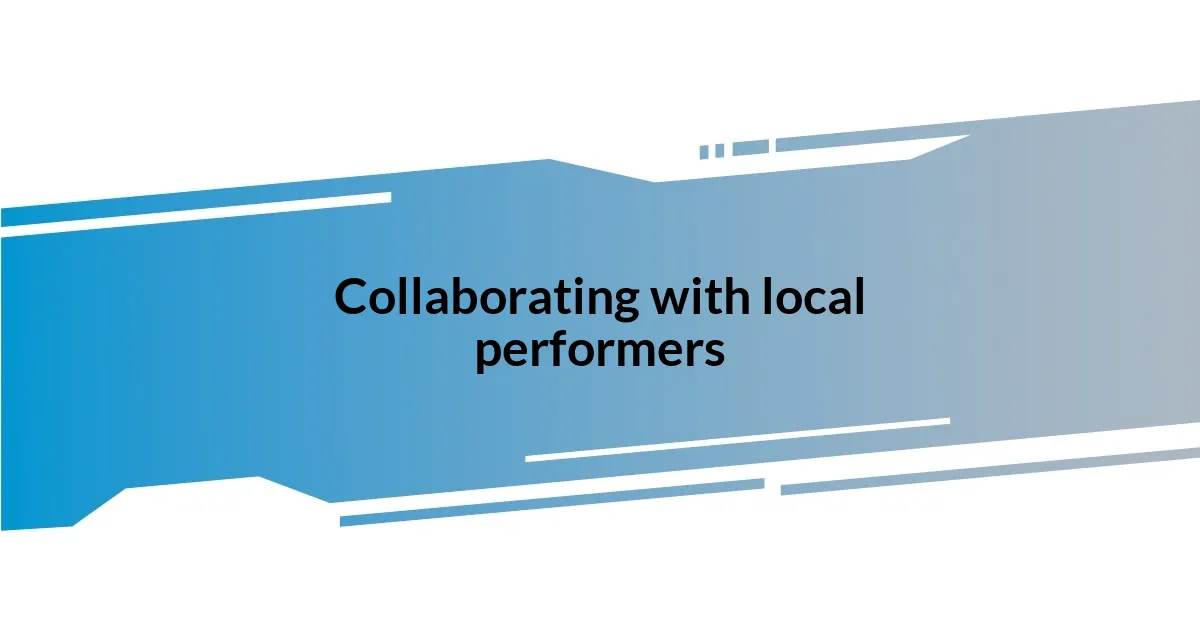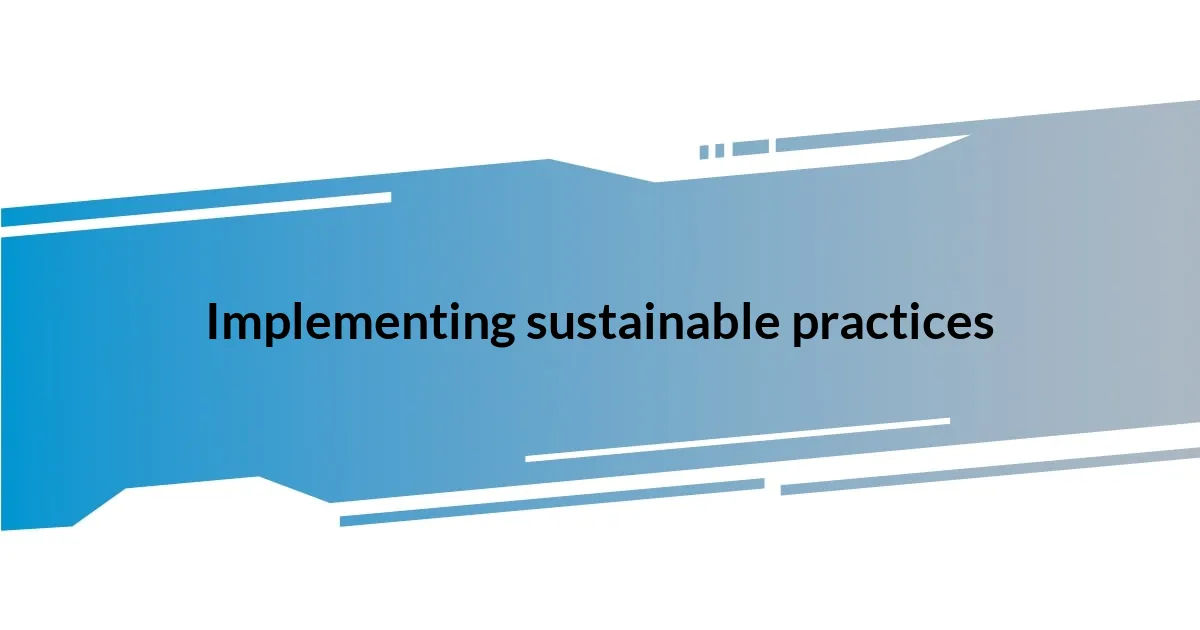Key takeaways:
- Festivals are evolving to reflect societal values, emphasizing inclusivity, sustainability, and diverse programming.
- Incorporating new technologies, such as mobile apps and live streaming, enhances audience engagement and broadens accessibility.
- Collaboration with local performers and implementing sustainable practices enriches the festival experience while fostering a sense of community.

Understanding festival trends
Understanding festival trends requires a keen eye on societal shifts and cultural narratives. I remember a summer festival where the line-up reflected not just music, but a shift towards inclusivity. It made me wonder—how do the artists and themes we celebrate mirror our evolving values?
It’s fascinating to see how festivals adapt to incorporate sustainability. During my last visit to a local fair, I was struck by the eco-friendly initiatives, from compostable cups to art made from recycled materials. It made me think: how can we incorporate these values into our festivals to shape a better future?
Embracing diversity in festival programming is another trend that can’t be overlooked. At one event, I was introduced to artists from backgrounds I had never considered, and it opened my eyes to new perspectives. This experience left me asking—how do these diverse voices enrich the festival experience for everyone involved?

Identifying changing audience preferences
Identifying changing audience preferences has become an essential skill for anyone involved in organizing festivals. I still remember my initial surprise when I noticed how younger audiences were shifting towards experiences over mere entertainment. This became evident during a festival where immersive installations replaced traditional stages, creating an environment where attendees could connect with art and each other in ways that resonated deeply.
- Increased demand for interactive experiences—participants want to engage, not just observe.
- Preference for local and sustainable vendors, reflecting a desire for community connection.
- A growing interest in mental health and wellness activities at events, showing a shift in priorities for attendees.
- Focus on diverse programming that celebrates various cultures and styles, illustrating the audience’s evolving values.
These observations have reinforced my belief that truly understanding the audience means constantly adapting to their voices and preferences. It’s a dynamic process that demands attention and empathy.

Embracing new technologies and platforms
Embracing new technologies and platforms has transformed how festivals connect with audiences. I vividly remember attending a festival that utilized a mobile app for ticketing, schedules, and social interaction. This innovation not only streamlined the experience but also made it so much easier to find friends in a bustling crowd. It made me realize just how essential technology is becoming in enhancing our festival experiences.
As I explored streaming platforms, I was amazed by how virtual attendance opened doors for many who couldn’t physically attend events. At one festival, I watched performers and participated in discussions live from my living room, feeling an unexpected sense of community. This shift toward hybrid experiences has taught me how powerful it is to blend the digital world with in-person interactions, creating a more inclusive atmosphere.
The advent of social media has revolutionized festival promotion, allowing for real-time engagement with audiences. During a smaller local festival, I noticed how vibrant social media posts attracted spontaneity, with people arriving on-site after seeing friends enjoying the festivities online. Integrating these platforms into festival marketing has now become part of the strategy, proving that authenticity and connection resonate deeply with attendees.
| Technology | Impact on Festivals |
|---|---|
| Mobile Apps | Streamlined organization and enhanced attendee connectivity. |
| Live Streaming | Broader reach and accessibility for remote audiences. |
| Social Media | Facilitated real-time engagement and spontaneous attendance. |

Collaborating with local performers
By collaborating with local performers, I’ve discovered a unique way to enrich festival experiences. I remember a festival where I partnered with a local dance troupe; their vibrant, cultural performances not only attracted attendees but also showcased the region’s artistic talents. Engaging local performers fosters a sense of community that resonates deeply with festival-goers, creating connections that feel genuine.
One of the most rewarding moments for me was when we introduced a stage dedicated to emerging artists. It was exhilarating to see how excited they were to share their art, and it reminded me of my own beginnings in the arts scene. Do you remember the energy of supporting someone who is just starting? It’s infectious. Local performers often bring fresh perspectives and reflect the diversity of the audience, transforming a festival from merely an event into a celebration of shared culture.
Moreover, collaborating with local talent boosts engagement among attendees. When people see familiar faces or styles, it strengthens their emotional connection to the event. During one festival, I noticed a crowd buzzing with excitement as local musicians took the stage, their songs filled with stories that resonated with our community’s values. This authentic representation adds depth to the festival experience, compelling others to participate and support the arts in their locality.

Innovating festival experiences
Innovating festival experiences allows us to create moments that linger in attendees’ memories long after the last note is played. I recall a festival where we introduced immersive art installations that transformed ordinary spaces into extraordinary experiences. It fascinated me how each installation invited attendees to interact, igniting their creativity and curiosity. Who knew that a simple change in the environment could spark such joy and connection?
In another instance, we experimented with wellness activities alongside the main events, like yoga sessions at sunrise. I still remember how refreshing it felt to stretch with the rising sun and a crowd of eager participants, all of us powered by the festival vibe. It made me reflect on how blending different experiences can rejuvenate and elevate the atmosphere, ultimately attracting a wider audience.
Food has also become a pivotal part of innovating festival experiences. At one festival, we curated a culinary journey featuring local vendors and unique dishes. The overwhelming aroma of diverse cuisines wafting through the air was mesmerizing. I fondly recall chatting with attendees who were excitedly sharing their latest food discoveries, revealing how food can unite people in delightful and unexpected ways. Isn’t it interesting how a plate of food can break down barriers and create a sense of belonging?

Implementing sustainable practices
Implementing sustainable practices has become a crucial aspect of modern festival planning. I vividly remember the day we made the decision to eliminate single-use plastics from our events. The moment we unveiled our new biodegradable cups and cutlery, attendees reacted positively, and it felt rewarding to witness their willingness to embrace such changes. Isn’t it amazing how small shifts can lead to significant impacts, not just on the environment but on our community’s consciousness?
In another festival, we took a bold step by partnering with local farmers to source all our food products. I still smile thinking about the excitement in the air as festival-goers tasted fresh, locally grown produce. It not only supported the local economy but also changed the dialogue around what festival food can be. Have you ever noticed how connecting with local sources can create a richer and more authentic experience for everyone involved?
Moreover, we embraced renewable energy solutions, utilizing solar panels to power stages and lighting. I’ll never forget watching the sun set over the festival as solar lights illuminated the space, creating a magical atmosphere. It made me think about our role in driving change within the community—every watt of energy produced sustainably felt like a step toward a better future. Isn’t it inspiring to imagine festivals as a platform for eco-consciousness?

Measuring success and gathering feedback
To truly gauge our success, gathering feedback became an essential practice. After each festival, I found myself hungrily combing through surveys and social media comments. What surprised me the most were those moments when attendees shared how a particular performance or feature resonated deeply with them. Their heartfelt words not only validated our efforts but also highlighted areas for improvement.
One time, a attendee reached out after a festival to share how a wellness workshop had profoundly impacted her life. This personal connection reminded me that metrics, while important, don’t always capture the genuine human experiences we create. Hearing stories like hers inspires me to keep innovating and adapting our offerings to meet the audience’s evolving needs.
During our brainstorming sessions, we often referenced feedback to steer our future direction. Analyzing trends in attendees’ preferences helped us refine our programming, ensuring that we remain relevant. How often do we forget the power of listening? I learned that paying close attention to feedback transforms how we approach festival planning, building a stronger connection with our audience and enhancing their experience.
